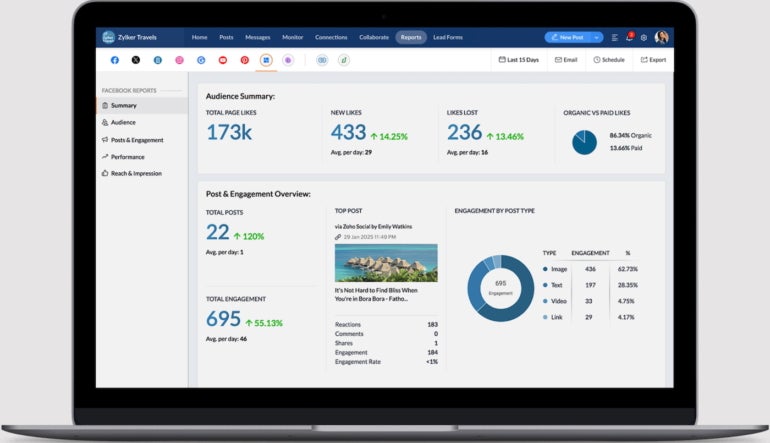Enterprise CRM software is a customer relationship management platform specifically designed for midsize to large organizations that need a solution that can handle the bandwidth of a large-volume business. With the right software, businesses can scale high-level automation, such as deal tracking, client engagement, and team management. Some of the most notable providers include Zoho CRM, HubSpot, and Pipedrive for their scalability, cost efficiency, and marketing and sales features (they’re also among the best AI-powered CRMs). The providers I examine below organize and track current and past client activity through custom workflows and pipelines with advanced tech features. These tools help teams, departments, and entire enterprises access the same up-to-date information through visually digestible dashboards. 1 monday CRM Employees per Company Size Micro (0-49), Small (50-249), Medium (250-999), Large (1,000-4,999), Enterprise (5,000+) Any Company Size Any Company Size Features Calendar, Collaboration Tools, Contact Management, and more 2 Pipedrive CRM Employees per Company Size Micro (0-49), Small (50-249), Medium (250-999), Large (1,000-4,999), Enterprise (5,000+) Any Company Size Any Company Size Features Calendar, Collaboration Tools, Contact Management, and more 3 Creatio CRM Employees per Company Size Micro (0-49), Small (50-249), Medium (250-999), Large (1,000-4,999), Enterprise (5,000+) Large (1,000-4,999 Employees), Enterprise (5,000+ Employees) Large, Enterprise Features Dashboard, Document Management / Sharing, Email / Marketing Automation, and more Top enterprise CRM software compared The top enterprise CRM tools offer a variety of core features, like contact and account management, basic reports and dashboards, and activity tracking. After building pipelines and reports in the software, information and activity updates can be shared through the CRM’s integrations with other applications, both native and third-party. This way, accounts and pipelines are visible across teams and entire departments. Key enterprise features Marketing automation: Manage campaigns with marketing attribution, send mass emails, and use the Social Tab to launch Facebook and X campaigns. Advanced CRM analytics: Run anomaly detection, comparator, cohort analysis, and quadrant analysis for an in-depth understanding of customer behavior. Zia AI: Zoho CRM’s native AI tools include smart lead scoring, recommendations, data enrichment, email summarization, sentence auto-complete, call transcription, and sentiment analysis. Advanced customizations: You can customize page layouts, subforms, web tabs, reports, dashboards, email templates, and buttons. Zoho CRM social media analytics. Image: Zoho Pros and cons Pros Cons Social Tab for social media marketing and management Workflow rules and automation are available across all plans 24/7/365 data security Difficult UI due to advanced and robust features 24/7 customer support requires an add-on User-reported issues with data migration and deduplication HubSpot CRM: Best all-in-one enterprise CRM Overall rating: 4.62/5 Cost: 4.31/5 Core features: 4.53/5 Ease of use: 5/5 Support: 4.38/5 Expert score: 4.38/ Image: HubSpot HubSpot CRM offers a variety of sales, marketing, and customer service management tools. You can organize and engage with clients through phone, live chat, and email, and manage activities within a custom dashboard. Then, you can sync customer data across an array of third-party integrations. Moreover, despite its robustness, it uniquely maintains a low learning curve, making it great for those who want to deploy an easy-to-use CRM across a large organization. Why I chose HubSpot CRM HubSpot CRM is top-rated for its robust set of features. In addition to its sales, marketing, and service capabilities, it also offers specialty tools for managing commerce, content, and operations. Its notable features include company insights, an AI email writer, live chat software, and a meeting scheduler. Enterprise-level features include lead form routing, recurring revenue tracking, deal journey analytics, and custom user roles. For more information, read our HubSpot CRM review. Pricing Free CRM: Free for up to two users with contact management, quotes, live chat, and more. Sales Hub Starter: $15 per seat per month, billed annually, or $20 when billed monthly. The Starter plan includes all free tools, simple automation, e-signature, conversation routing, and more. Sales Hub Professional: $90 per seat per month, billed annually, or $100 when billed monthly, and a one-time $1,500 onboarding fee. This plan includes all Starter features and prospecting workspace, playbooks, forecasting, and more. Sales Hub Enterprise: $150 per seat per month, with an annual commitment and a one-time $3,500 onboarding fee. Users of this plan receive all Professional tools plus advanced permissions, predictive lead scoring, conversation intelligence, and lead form routing. Key enterprise features Breeze Prospecting Agent: Leverage AI-powered research to build a qualified sales pipeline and personalized outreach strategies. Sensitive data storage: Securely store sensitive data like demographics, financial data, and government ID inside your HubSpot database. Advanced permissions and notifications: Create custom user roles, granular permissions, and default notifications for all users or profiles in your HubSpot account. HubSpot CRM email marketing template. Image: HubSpot Pros and cons Pros Cons All-in-one CRM with sales, marketing, service, and commerce tools Intuitive user interface Offers specialty tools for content and operations management Enterprise tier requires an annual commitment Mandatory one-time onboarding fee for higher tiers AI-powered data enrichment requires a $45 per month add-on fee Pipedrive: Best for visual pipeline management Overall rating: 4.54/5 Cost: 4.25/5 Core features: 4.53/5 Ease of use: 5/5 Support: 4.06/5 Expert score: 4.19/5 Image: Pipedrive Pipedrive is a straightforward CRM system that focuses on building competent sales pipelines for tracking deals and managing leads. Businesses can automate their sales process with Kanban drag-and-drop tools, making it an easy platform to navigate and customize. This platform also offers resources on implementing the tool according to your niche industry, like automotive sales, call centers, banking, or B2B/B2C organizations. SEE: 10 Best CRM Software for 2025 Why I chose Pipedrive Pipedrive offers a highly visual drag-and-drop interface, making it great for reflecting sales and marketing processes. Creating these Kanban-like pipelines makes it easier to manage new leads and existing clients from one place. Pipedrive is intuitive software that allows individuals to navigate and identify potential sales opportunities, making it the best enterprise CRM for visual pipeline management. Pipedrive’s pipeline builder is pretty clear-cut and visually appealing, so if you want a similar intuitive interface for creating sales processes at a lower cost,













